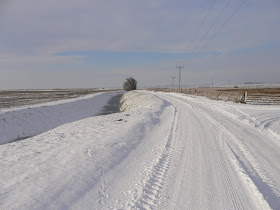I apologise firstly, for the map below, which fails to show the mouth of Windmill Creek to the east of Elmley and alongside Spitend. However, looking at the map below, and the left hand side, you will see that Elmley Island begins as a small bay/inlet on the Swale side of the seawall. This inlet is directly opposite Ridham Dock and originally led into a part tidal/part freshwater creek known as The Dray.

The photo below shows The Dray as it is today, a wide fresh water fleet just inside the seawall. At the base of the photo is the top of the current sea wall.

This photo shows the seaward side of the entrance of The Dray, in effect seperated from The Dray by the dam that is the seawall. It is easy to imagine how it must of looked pre. seawall times, when especially on high Spring tides, the sea would have flooded inland along The Dray for some way.

Less than half a mile from The Dray's start above, this is how it currently crosses the Elmley track, as little more than a ditch, with low counterwalls either side. The counterwalls are the give away however, with the sea flooding in on a daily basis, it almost certainly must of been wider than it currently is, on a regular basis.

The Dray continues in this much reduced way for about a mile before eventually widening again as it approaches Southlees Marshes on the Minster side. Whilst it was always tradionally wider in that area, it has been much improved at this point in modern times by the farmer on its northern bank. The Dray here is now maintained in its wide and deep form and well fed with corn because the farmer on the Minster side leases that stretch out to a duck shooting syndicate because of the large numbers of wildfowl that he attracts.
Not far past here The Dray appears to peter out and that is because at the point designated on the map as Newhook Marshes it then became Windmill Creek, at its most inland point. However at this point and after the 1953 floods, that stretch of The Dray/Windmill Creek was used as, and filled in, as a Council Refuse Dump. The dustcarts would come in via Brambledown on the Leysdown Road, travel down via Poors Farm and deposit their loads. I remember when I first started rabbiting on Elmley in the early 1970's that the Dump had just come to the end of its life and was being levelled and grassed over and fenced in.
From there down to The Swale, Windmill Creek was, until 1953, tidal and there was even a small quay or two on the Eastchurch side that small sailing vessels used when delivering/receiving farm produce. There was a quay at Newhook for instance and I can clearly remember seeing it still there and un-used in the early 1970's.
The event that changed Windmill Creek for ever were the floods of 1953. These floods, the result of a high water storm surge pushed down the North Sea by gale force winds, flooded most of Eastern England and Holland with the loss of many lives, livestock and property. The low lying areas of Sheppey were particually badly flooded and Windmill Creek was one way that saw the counterwalls either side over-topped and the marshes flooded. Even in Sheerness, where I was a 6yr old boy, we had flood water part way up the stairs of our house and to the top of our gas cooker in the kitchen and the milkman delivered milk by boat in every street - we took in the milk by lowering a bag down on a rope from the bedroom window. From that event on the seawalls all round Sheppey were raised and at Windmill Creek a dam was built across the entrance, forever joining Harty with Elmley.
It eventually created on the inward side of the old Creek, a wide stretch of fresh water for a mile or so that was particually attractive to wildfowl, etc, and as I found out in the early 1980's, a brilliant source of flounders of all sizes!
That pretty much covers Elmley as an Island except for an historical event that ended on the Elmley side of the new dam. On September 7th 1940, at the height of the Battle of Britain, Flt. Lt. Hugh Berrisford in his Hurricane of 257 Sqd was shot down over the Thames Estuary and crashed into the marshes at Spitend, Elmley. In 1979 the Wealden Aviation Archaeolical Group identified the crash site and as part of a BBC TV programme, excavated the crash site. It was literally alongside the Dam on the Elmley side and because of the soft marshland soil the plane had gone in to a depth of 30ft. The dig however excavated much of the plane, alongside remains of the pilot's body. I can recall going to the site the day after the dig whilst on Spitend rabbiting and breaking open some lumps of mud and discovering part of Berrisford's check shirt, still buttoned up, in one of them
So, that is The Island of Elmley, created by both The Dray and Windmill Creek, from Ridham Dock all the way round to Windmill Creek near to Harty Ferry.



























